When we think of anchoring a yacht we think of the obvious — deploy and set an anchor from the bow with a single rode. Our yachts (and most vessels) are geared up for this simple practice, which has been found safe and effective for decades. Most of us have a bow roller, chain locker, and many yachts have a windlass. Although this arrangement is typical—it is actually not standard throughout the world, and there are niche variants that could be very usefully employed in many locations.
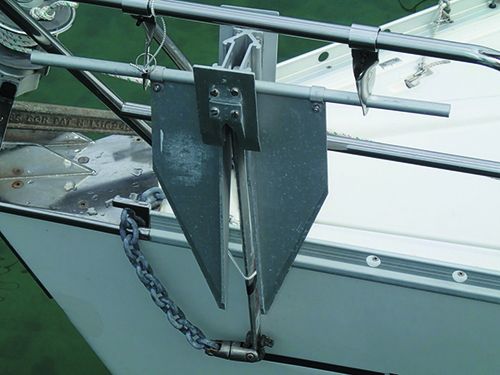
Two anchors set in V-shape
One of the simplest variants is to use two anchors set in a V-shape. Commonly, this is thought of as a means of adding holding capacity to supplement an inadequately sized anchor or offer reassurance in a strong wind event and exposed anchorage. When some hear that an owner uses this practice, their immediate reaction is to suggest it would be better to use a bigger anchor, but this misses the point completely.
Anchoring in a ‘V’ does not necessarily increase holding capacity. The tension is mostly concentrated on only one anchor at a time. The “off” anchor on each swing absorbs very little load.
The benefit in anchoring in a ‘V’ is to minimise the impact of a wind that veers, first gusting from one direction then another, maybe with a 30- or 45- degree difference in direction. Veering is common as the wind shears when it meets land. The wind can also veer as it generates bullets or williwaws down valleys and gaps in the trees, especially in tight anchorages.
If you want to see veering at work – simply watch aircraft landing at an airport in strong wind. The average wind direction is stable but the aircraft veers from side to side as it approaches the runway. Your boat has the exact same issues.
Another benefit of anchoring in a ‘V’ is to tame yawing caused by excessive windage in the bow—the dinghy housed on the foredeck, for example. If you anchor in a ‘V,’ each anchor is set to absorb each extreme of the veer. Thus each anchor in turn is tensioned in the set direction, and the set direction is the direction of maximum hold. Set this way, each anchor is operating to maximum advantage.
If you only use one anchor it is constantly being tensioned in a variety of directions, pulled this way and that. It does not matter how big your anchor is, if it is constantly tugged from different angles, it has potential to drag.
Anchoring in a ‘V’ reduces veering. Leaving a yacht to veer can be debilitating for the crew and a tired crew will be unhappy. Moreover, veering is thought to be a significant contributing factor for an anchor to drag, so minimizing for veering with two anchors is good seamanship. In a recent series of articles on anchoring with all-rope rodes, PS looked closer at ways to minimize veering (see “Rest Easy with a Riding Sail,” PS August 2019).
In any ‘extreme’ anchorage, the visitors often make do with what they have, while the locals have dedicated equipment—making life much easier. Often the best arrangement for your boat isn’t found at the local chandlery, but rather in the mind of a local marine fabricator. We’ve seen several creative solutions for facilitating shore-tying.
- A yacht from Malta in Punta Arenas. Needs must, Shore line rope stored in a laundry basket and 2 CQRs draped over the pushpit.
- Here is a typical tape reel, and one way to store an anchor and a short chain rode on the stern of a yacht in the Baltic.
- A custom built stern roller. Note the rode hawse pipe in the rear of the lazarette.
- A rope reel built into the pushpit with a Danforth anchor attached to the top rail of the pushpit.
- An Argentinian yacht well equipped with shore lines, retrofitted neatly to the pushpit.
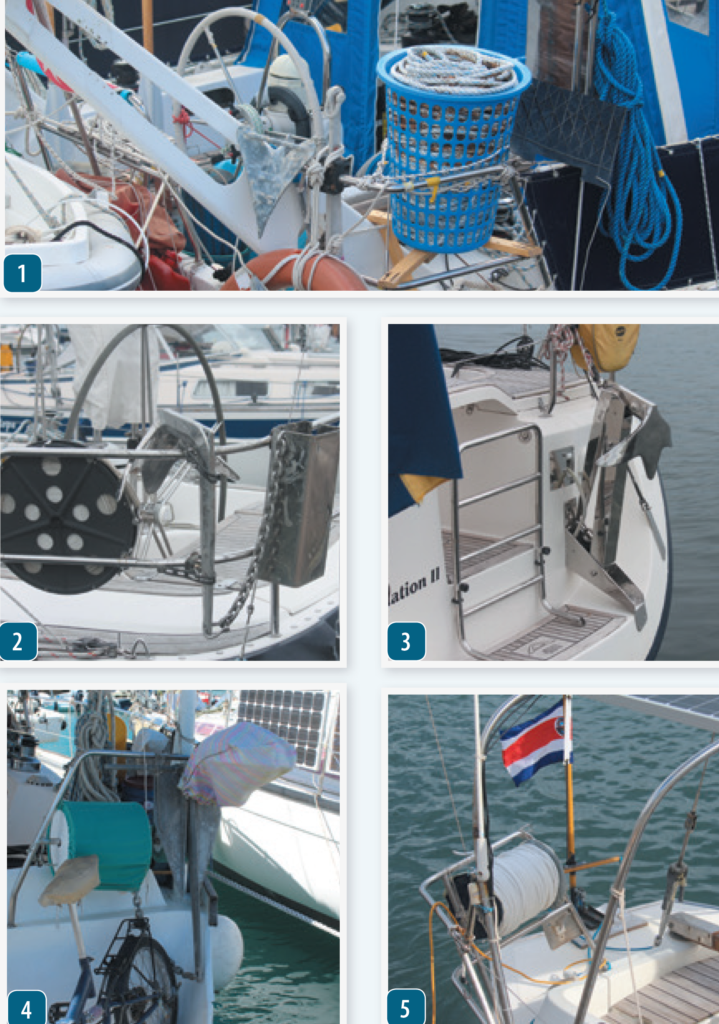
Setting Anchors from the dinghy
Ideally, if you use two anchors set in a V-shape, you have twin bow rollers (with an anchor on each). Sadly most modern yachts, even large yachts, are increasingly provided with only one bow roller. This is not a major impediment. You can still deploy a second anchor, locking off the rode on a bow cleat, but ensure the rode is protected from chafe, and the deck and bow are protected from the chain.
If your yacht has a propensity to veer, then your first task is to identify and minimize the veering.
We use unusually light anchors for the size of our boat. We use two 8-kilogram (~20 pound) aluminium anchors. If winds in our chosen anchorage are likely to exceed 35 knots we will deploy a second anchor, just in case.
Even if we doubt we’ll need a second anchor, we set it anyway because it will be a lot more stressful to set the anchor at 2 a.m., if we do need it. We often deploy the second anchor from the catamaran bow by slacking the primary anchor and motoring to the desired anchor location, which can be easy to pinpoint using a chartplotter. The alternative is to deploy from the dinghy. This is one advantage of lightweight anchors, they are easy to handle and good designs can have the same holding power as similarly designed steel counterparts.
When I deploy from our dinghy, the aluminium anchors make things easier. First, we confirm our position by taking shore transits and we prepare on deck the amount of rode we want to deploy, plus some extra to set the anchor. This helps ensure that we put the second anchor in the correct location (in terms of the angle of the ‘V’ and the length of the rode).
I attach the anchor to the outside of the transom with a slip knot with rode attached. My partner, Josephine pays out the rode as I row to the chosen location. When I reach the defined distance from the bow to deploy I simply activate the slip knot. This practice means I don’t have loose rope or chain in the dinghy (to get round my feet), I row until all the preset rode is deployed and I don’t destabilise the dinghy when I drop the anchor to the seabed.
If we plan to stay in an anchorage for more than one night our practice is to hold one of our quiver of anchors (each of which is big enough to be the primary) near the bow with the spare rode, and anchor attached to the rode.
Our spare rode is 45 feet of 6 millimeter (~1/4”) high-tensile chain and 120 feet of 12 mm (~1/2’) three-strand nylon. The rope is marked with red ribbons through the strands every 30 feet. We religiously coil the rope around the inside of a milk crate and fill the hollow center (left by the coils) with the chain, shackle attached. The bitter end of the rope is not at the bottom of the coils but left hanging free and it can be cleated off on the boat before I set off in the dinghy. We keep spare shackles attached to the milk crate—ready if needed.
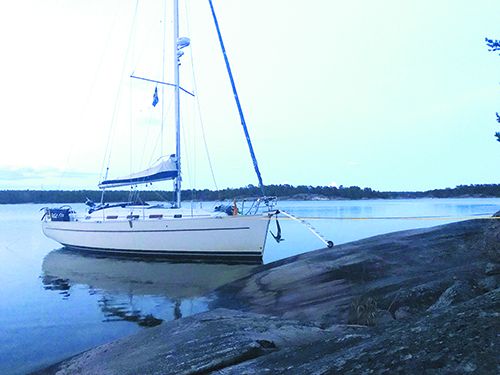
A ‘Quiver’ of anchors
No anchor is perfect. Those who cruise widely should carry a spare anchor of adequate size to be the primary in case you lose an anchor. Additionally, a good anchor in sand may not be the best in soupy mud, so carry anchors that offer holding in a variety of bottoms. We carry a Spade anchor, an Excel anchor (from Anchor Right in Australia), a Fortress FX16 (stored with the flukes set at 30 degrees), and a Fortress FX37 (for soupy mud, stored with the flukes set at 45 degrees). All the anchors are aluminum, and all weight about 8 kilograms (~ 20 pound). On a typical three-month cruise, we’ll use all of them at one time or another (but not all at once!).
Dropping a stern anchor or a bow anchor for a Baltic or Med moor takes some practice to get the distances right. In the Mediterranean you can judge distances relatively easily as you will be mooring with other yachts whose length you can judge fairly accurately. They will also have anchors deployed, giving two factors to allow a good judge of where to drop your own anchor. In the Baltic there are no such aids (as you would much more commonly anchor in splendid isolation). At least this way, if you want to correct your initial anchor set, you are not providing any entertainment for those on shore!
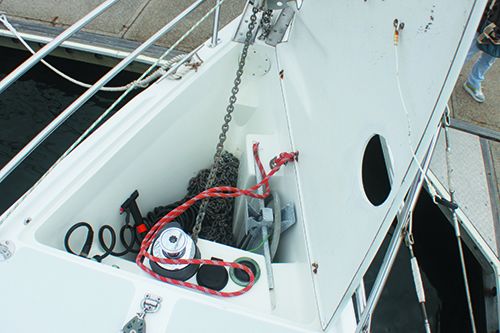
High latitude tactics
In high latitudes, different problems exist and completely different solutions have developed. The main issues are harsher weather, deeper water, poor holding and much less detail, if any, of the anchorages. The holding ground cannot always be considered reliable, and most yachts will carry ample shore lines. Frequently they will use as many as four lines each night—plus anchors.
Shore lines will be long, about 300 feet. Storing and handling 300 feet of rope is not easy, and yachts have a whole host of ways to manage the cordage. We have seen rope simply stored in large duffle bags, laundry baskets, spinnaker bags (the hoop openings come in handy), and conventional rope reels. The rope reels can be attached to and incorporated into the pushpit or located on brackets on deck. These reels can be removed when at sea. No high-latitude ‘expedition’ yacht explores the world without rope reels or the equivalent equipment for shore-tying.
Deploying shore lines in high latitudes demands dinghy access and sometimes gymnastics to get ashore. In isolated locations trees might simply not be available and there might be no conveniently sized rocks. Rock climbing pitons, rock climbing wedges, and even short lengths (18-inches/450mm) of steel reinforcing rod and a decent hammer can be invaluable. We store these with a hammer and spare shackles in a dedicated bag that we take in the dinghy with us when we go ashore to look for points to secure the boat.
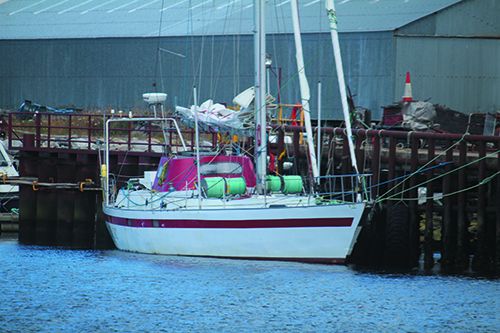
Shore ties and accessories
Several sailboat equipment makers have introduced gear to cope with these unusual mooring needs, but there is still a lot of improvising (thus the laundry baskets and climbing gear). In any ‘extreme’ anchorage, the visitors often make do with what they have, while the locals have dedicated equipment—making life much easier.
Perko and Windline in America make brackets dedicated to Fortress anchors and Mantus make a universal bracket for most anchors.
There are a number of suppliers of tape reels (pre-filled with a variety of tapes, including Dyneema). The makers of the Ultra anchor entered the marine market with their Quickline reels (see PS December 2006). Reels for rope are easier and more common place, robust garden hose reels work well.
Chandlers in the Baltic also supply ‘stern rollers’ for the anchors, but a good stainless-steel fabricator could make one easily for your specific yacht. Most major harbors have a talented welder or fabricator who could custom build a reel. Local artisans are often overlooked as a source of equipment.
To secure our catamaran at the stern, we have a bridle attached to horn cleats on the stern. There is an eye in the centre of the bridle, so that we can take one stern line ashore and keep the cat roughly perpendicular to the shore. We have enough rope for two generous shore lines. We also have our spare rode—75 feet of 6 mm (1/4-inch) high-tensile chain and 120 feet of three-strand nylon). We certainly don’t need this kit for sailing in home waters of Australia, but in Tasmania it’s a different world. There, the retired Dyneema halyards, the pitons, and the steel reinforcing rods all come in handy.
One use for shore lines is to allow more yachts to be able to access tight anchorages. Yachts that don’t swing take up less room. This is one reason stern-to Med mooring has developed. It allows more yachts to access an historic quay in a delightful atmospheric location.
These techniques could be advantageously used in many locations round the world— not just in the Baltic, Mediterranean and the higher latitudes. Using shore lines makes some sheltered spots feasible that would otherwise be totally unacceptable.
Whatever you do with shore lines—no matter how isolated the location—mark the lines and use an anchor light. If your chosen location is the only sensible shelter for miles, you may soon have visitors. Local fishermen may arrive tired and cold in the dark, unaware that your lines present a new hazard.
It is a simple courtesy to mark the shorelines, and ensure these late arrivals don’t get your ropes round their prop. Brightly marked floats are an obvious solution. We’ve seen water-proof flashing LED lights used at night. And for lines above the water, reflective tape or even old compact disks can work.
Like any sailing art, anchoring always involves some improvising. The more you venture off the beaten path, the more prepared you need to be to get creative. That doesn’t mean you need to run out and buy all the gadgets you see on high-latitude cruisers, but you will need a good assortment of lines, shackles, and anchors.
Jonathan Neeves is a longtime contributor to Practical Sailor. He and his wife Josephine cruise a Lightwave 38 Josepheline in their home waters of Australia.
































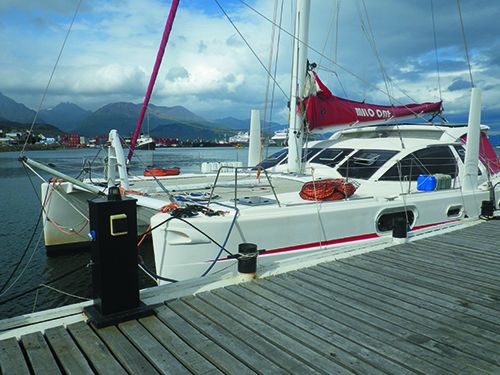




I read with interest your article Lateral Thinking and Anchoring. We have sailed in the Med and often used the Med Moore. However sometimes when there is no room at the quay some harbour’s provide an area where you can drop anchor and then tie your stern via a “long line” to a ring bolt on shore. The down side is that you need to take your dingy to shore but at least you are in the harbour. I have often wondered about the physics of this. It seems to me that any wind hitting you on the beam is going to amplify that force onto your anchor, possibly 10 times or more. In a calm situation this is no problem but if the wind picked up you could end up dragging your anchor. Just wondering if some of the experts at Practical Sailor could comment on this.
The mooring system you describe is not unique. In some Asian ports, Korea, Thailand, and maybe others, a central mooring facility is provided and vessels anchor in a star like formation and there can be 10s of vessels secured. However we have only seen this used for commercial vessels, primarily largish fishing boats.
Your assessment is correct ‘anchoring’ beam on to the wind will impose much larger forces on the anchor than those for which it is designed and specified as the beam on windage of monohulls is factorially greater than their head on windage. To mitigate the issues if you are in a harbour, there should be shelter from other vessels, the shore and the seawall round the harbour and of course the load is shared by your anchor and whatever the harbour has provided. Hopefully there will be no swell nor chop. Because your anchor is laid also beam on to the wind you will never be able to rely on its full hold – as sideways hold will be much less than hold in the ‘set’ direction. Personally we would not want to find ourselves forced into such an anchoring pattern and were there to be a strong wind forecast that might make us twitchy we would want to seek shelter elsewhere. If moving was impossible then laying an anchor, or 2, at 90 degrees to the beam – in the direction from which the wind is forecast – as well as a stern anchor would seem prudent. This is but just one more reason why your spare anchors (note the plural) should always be large enough to be considered a primary and should not be of a design you would not use as a primary. So – if you have a ‘new gen’ primary – you should have ‘new gen’, equally sized, second anchors. Carrying a spare anchor that you retired as being ‘inadequate’ seems contradictory.
All our anchors are aluminium alloy, we carry 4 in total, and cumulatively their weight is that of 2 steel anchors of a size recommended for our catamaran. Frankly we cannot differentiate between the performance of our alloy anchors from their steel counterparts (its design not weight, the idea anchors should be heavy is so very 20th century and ‘Bigger is Better’ has no technical basis that we have seen) and having multiple ‘spares’ to us is not an issue. You will need a spare rode, or have the ability to cobble together spare rodes.
Jonathan
Thanks for your informative response Jonathan. That’s what I’ve been thinking.
Rudy,
You are most welcome. Great minds think alike 🙂
Jonathan
Hi Jonathan,
I enjoyed our online discourse during lockdown last March but seem to have lost your email address. I am pursuing Armorgalv and wanted to bother you with some questions. Psheaffer g mail
I hope this reaches you well and happy
Cheers,
Paolo
Paolo,
I’ll make a search for your email and contact you direct – if you don’t hear from me (which means I cannot find your address) – ask Darrell for my email address.
I don’t recall your location but a 70m x 6mm G100 chain is scheduled to be Armorgalv coated in the next few weeks, in Australia. I ‘managed’, unpaid OC manager, 2 rodes about 9 months ago 100m of 8mm and 100m of 6mm – Its almost a standard process now. I’m not in this for a commercial reasons – and thus don’t promote – people hear of Armorgalv though Practical Sailor.
Ours is 4 or 5 years old now and the galvanising is standing up well. A side effect has been that in use the coating polishes and looks like black stainless. Like black stainless it is slippery and any chain towers slither away. But if you down size – you do need to use a decent snubber.
Jonathan
Unless you’re storing the line in a figure eight, paying out a line, which was stored as quoted below, will eventually result in hockling.
“We religiously coil the rope around the inside of a milk crate and fill the hollow center (left by the coils) with the chain, shackle attached.”
Wayne – You are quite correct.
In the dim past I and thousand of others used 3 ply nylon rope when rock climbing (the rope has since be consigned to history and we all use a kermantle now). We coiled the 3 ply rope after use and slung it on our shoulders or stored it across the top of our back packs. If you look at photos from the period of climbers, Chris Bonnington (now Sir Chris), Joe Brown, Don Whillans, after a climb – they all had their rope slung on their shoulders, without it being a figure of eight. When we, all, coiled rope it was second nature to coil giving the rope a reverse twist with every coil simply using finger and thumb. We use the exact same technique when coiling and storing in a milk crate – no hockles no figure of eight. Today there is no need as climbing rope is a totally different construction – and I consciously have to be careful not to give it a reverse twist – or it hackles 🙁
Jonathan.
Many years ago in the Bahamas I learned about the ‘problem’ in putting out two anchors. As noted in the article, it’s rare that the wind/current will be positioned so that both anchors are carrying a load. In my case one of the anchors began dragging and it wasn’t long before it became tangled with the other anchor and caused it to also begin dragging. At that point, with both anchors tangled together, we were being blown back toward a lee shore w/o any alternatives but to cast off both anchors and motor into the squall until it had passed. Fortunately the shallow and clear Bahamian waters allowed us to recover both anchors. However, ever since that time I’ve believed that it’s best to deploy a single large anchor with plenty of chain. I also carry a ‘spare’ anchor on the bow in the event that a ‘second’ anchor is needed.
Its a whole new discussion but a bigger anchor will not develop more hold than a smaller one, unless the smaller one is drastically undersized. The developed hold of any anchor is a function of the windage of the yacht and the seabed. A 15kg modern anchor will develop a hold of 2,000kg in a good holding seabed and a yacht for that size of anchor is very unlikely to develop a rode tension of 2,000kg. Use of a different anchor better suited to the seabed and use of an effective snubber (to manage the snatch loads) might be another option (to carrying an oversized anchor). An anchor that clogs in mixed weed/mud/sand seabeds will clog whether big or small. In soupy mud you need a Fortress, check PS Soupy Mud report of the Fortress/Chesapeake tests, as most other anchors (except a Danforth) don’t offer any reliability.
There is currently no perfect anchor – they are all a compromise.
What is common is the adoption of a modern anchor and using the ‘old’ anchor as the back up. If the old anchor was questionable – it will always be questionable – and one should not use a questionable anchor (at all). Whatever anchor you use as a primary then your spare/second anchor should be as good as your primary – you might lose the primary (it must happen quite often as there are many anchor makers).
We are currently long term testing a Viking 10 as our primary but have historically carried an Excel, Spade and Fortress (all of the size recommended by the anchor manufacturer for our 38′ catamaran. All our anchors are ‘lightweight’ (8kg), made from aluminium, except now, the Viking, 10kg, which is lightweight by virtue of being fabricated from High Tensile steel.
Jonathan
I too have tangled a pair of V-set anchor rodes in shifting Sea of Cortez “Chubascos” a couple of times. As a result, whenever I later felt the need because of special conditions to set V configurations, I retrieved the secondary one with less chain as soon as those conditions abated –frequently from the dinghy.
Untangling a pair of rodes that sustained more than one 360 degree shift is a mighty challenge without disconnecting one and some athletic SCUBA work.
Tim,
Our weather systems are such that bad weather comes from the south, off the Southern Ocean. We enjoy well forecast fronts that sweep up the coast. If we are heading south we shelter from these fronts (the seas can be large) in one of the few large bays on the coast. The bays tend to be low lying offering shelter from the seas but not the wind. As you suggest leaving the 2 rodes to tangle is not sensible – retrieving the second rode once the front has passed through saves a lot of heartache. We too would retreive from the dinghy – made easier as our anchors are all aluminium.Once the front has passed through and the seas subsided we would continue on our southerly passage.
Hello Jonathan – Sorry for my late arrival to the discussion. I recently read a detailed description of an alternate way of using two anchors (full description at schooner-britannia.com). In a nutshell, after lightly setting the main anchor with 3x depth, the second anchor is attached to the main chain rode with its own short 6 ft bridle. It also has its own rode back to the boat. Rope is fine for the second rode – no chain necessary, as this line won’t carry any stress. Both rodes are played out, and once on the bottom, the second anchor is also ‘set’ by reversing the boat. Then the remainder of both rodes is played out as required by depth. So the second anchor acts like a ‘kellet’, holding down the chain, but also digs in to the bottom to help holding power. There seem to be many advantages: 1. both anchors are set and holding all the time (instead of just 1 with V-pattern), 2. no tangling of two full-length V-pattern rodes due to tide/wind changes, 3. better ability to hold the chain on the bottom than a V-pattern, 4. setting/retrieving is not as complicated as the V-pattern alternative, and 5.less chance of another boater laying their anchor line over one of your V-pattern rodes. A second bow roller would probably make things easier. Have you experienced this alternative? Thanks for your thoughts.
Geoff
As they say – better later than never, welcome to the discussion.
The advantage of anchoring in a ‘V’ is that you are using two primary anchors, both sized for the yacht. You deploy the anchors so that they cover almost the extremes of veering. It does not matter how the wind veers one anchor is always set for the variation in wind and usually the 2 anchors are set such they ‘take’ it in turns to be the primary as the wind cycles from one direction to the next.
It is my belief owners should carry a spare anchor capable of replacing their bower. This effectively means the spare anchor is as good as the bower. I would not advocate carrying a second anchor as the one you ‘retired’ because it was not good enough and which you replaced with a modern anchor. If it was not good enough – leave it at home. I also recommend carrying a Fortress set at 45 degrees to use in this slushy mod – where most other anchors are simply inadequate. So all three anchors can be used as your primary as all 3 are sized for the yacht based on the anchor makers recommendations. The Fortress will be no use in weed – but the other 2 anchors should be chosen to cover the weakness of the Fortress (and effectively vice versa). If you do as we do – they are all aluminium and all easily managed from a dinghy. We carry weight saving to the extreme and use for our 38′ cat 6mm (1/4″ high tensile chain) of the same strength as 8mm (5/16th G30) 38′ cat – the 6mm is very user friendly in a dinghy.
Anchors drag for a variety of reasons – and veering winds are but one reason – anchoring in a ‘V’ manages that problem. Practical Sailor covered this in Jan 2020 and updated it January 2021. Other reasons for anchors dragging ar hobby horsing caused by chop and swell – and good snubbers help.
The arrangement you describe looks to me to be a variant of tandem anchoring, correct me if I’m wrong. Practical Sailor covered this in August 2016 and updated it Jan 2021. The weakness of tandem anchoring ‘in a line’ is there is a danger of the anchor near to the yacht lifting, completely, and then simply acting as a kellet. This will be exacerbated as the near anchor will be subject to yawing of the yacht (caused by wind shear or simply the characteristics of the yacht.). If the tide changes – the anchor nearest the yacht might take all the weather – it then has to work alone – anchors and anchoring are a compromise.
But – big BUT – there is no one right way to anchor, in the Baltic they anchor from the stern. In Patagonia or Labrador shore lines are common – its horses for courses – and what works for you with the ground tackle you carry. Anchoring in a ‘V’ is not going to be ideal in a change of tide or 180 degree wind shift – and you may need to reset the anchors (which is a bit of a faff – but that’s sailing)
Jonathan
Geoff,
Here are some links for you – to save searching. The first one is an extra, not one I referenced in my reply – but no less interesting.
https://www.practical-sailor.com/sails-rigging-deckgear/deep-anchors-stay-put-in-moderate-
yawing
https://www.practical-sailor.com/sails-rigging-deckgear/yawing-and-anchor-holding
https://www.practical-sailor.com/sails-rigging-deckgear/tandem-anchoring
Jonathan
Not a fan of any type of two anchor set up. When you need to exit an anchorage quickly, the absolute last thing you need is to be dealing with is two anchors. Single anchor, all chain, upgraded windlass with 3-4 times the static pulling power of the “stock” windlass. With 45,000 miles of cruising in our 35 ft monohull and 1000s of nights at anchor, we have never set a 2nd anchor. 45lb Manson. 250ft 5/8 inch chain. Windlass with 2800lbs static load. Our 2nd anchor still sits in the locker where we stored it more than a decade ago.
Two simple tricks are all you need. First, in the northern hemisphere try to position to be the northernmost boat in the anchorage. If you want to know why, just ask. 2nd, once you are comfy with your single anchor set, take a para drogue with 3 ft of chain attached and using a carabiner, clip it on to the chain one foot below the point where the chain enters the water. When the wind starts howling the bow always moves faster than the stern, causing the yawing effect. The para drogue will stream out as the bow starts to slide and slow it down, thereby allowing the stern to more or less stay in line. This reduces yawing, hunting, sliding, and the total distance the boat will travel before heading back the other way. It also slows down the speed of travel. Combine this with a riding sail and you will wonder why the heck you never previously knew this trick.
If you want to test it out before investing in a para drogue, use one or two 5 gallon buckets with a half dozen large holes drilled in the bottom, clipped to the anchor chain as described above. This also works, although eventually the handles will break or chafe through
If you don’t have all chain, then you can tie the drogue to the road, although it does not work quite as well and inhibits quick retrieval.
Would that be a 4-8’ parachute style drogue (as opposed to the Jordan (?) style used in series on a line? Just want to be clear…
I’m not sure that I would find retrieving a drogue through the confines at the bow of some yachts very easy. This is worse on a multihull as many have the windlass and chain locker just forward of the mast and access under the foredeck to retrieve a drogue simply does not exist. Many multis simply have a slot to allow retrieval of the chain and anchor shank. It would be real fun to squeeze a drogue through the hole. Riding sails are an alternative idea to control yawing and appear to have lost favour – I have not seen one in use in Australia in the last 20 years.
There is no one right answer, as there is no one right anchor. The key is being aware of other techniques, trying them and maybe modifying them to suit your particular situation or yacht design.
If we adopted Med mooring, Baltic mooring and made more use of shore lines some popular anchorages could accomodate many more yachts. Personally having close neighbours seems to contradicts some of the pleasures of anchoring but if it allows more yachts to gain shelter when it is really needed – its not something we should automatically reject.
Jonathan